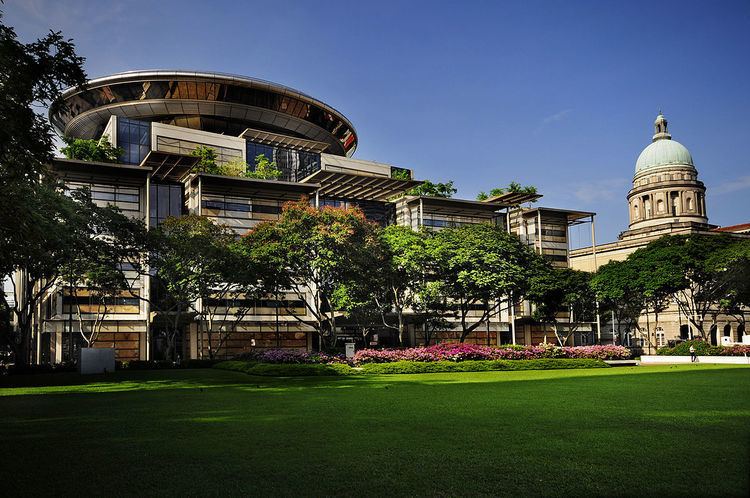 | ||
The Constitution of the Republic of Singapore Tribunal was established in 1994 pursuant to Article 100 of the Constitution of the Republic of Singapore. Article 100 provides a mechanism for the President of Singapore, acting on the advice of the Singapore Cabinet, to refer to the Tribunal for its opinion any question as to the effect of any provision of the Constitution which has arisen or appears to likely to arise. Questions referred to the Tribunal may concern the validity of enacted laws or of bills that have not yet been passed by Parliament.
Contents
Constitutional questions may also be referred to the Tribunal when Parliament attempts to circumvent or curtail the discretionary powers conferred on the President by the Constitution. If the attempt is by way of an ordinary bill, the President can exercise personal discretion to withhold assent to it. It is then open to Cabinet to advise the President to refer to the Tribunal the question whether the bill in fact circumvents or curtails his discretionary powers. If the bill is determined by the Tribunal not to have that effect, the President is deemed to have assented to the bill on the day following the day when the Tribunal's opinion is pronounced in open court. When Article 5A of the Constitution is brought into force, a similar procedure will apply to attempts to circumvent or curtail the President's discretionary powers through a constitutional amendment. If the Tribunal rules that the proposed amendment does have the effect of restricting the discretionary powers of the President, the Prime Minister is entitled to submit the bill to a national referendum for approval.
The Tribunal consists of not less than three judges of the Supreme Court. Its opinions are binding on all other courts. Since the Tribunal was established in 1994, to date only one constitutional question has been referred to it. The Tribunal determined in 1995 that although Article 5(2A) was not in force, Article 22H(1) did not prevent Parliament from restricting the President's discretionary powers through a constitutional amendment. Since then, there have been several unsuccessful attempts to persuade Cabinet to invoke the Article 100 procedure.
History
The Constitution of the Republic of Singapore Tribunal is an ad hoc tribunal established by Article 100 of the Constitution of the Republic of Singapore. Article 100 was introduced into the Constitution by the Constitution of the Republic of Singapore (Amendment No. 2) Act 1994, which was passed by Parliament on 25 August 1994 and assented to by President Ong Teng Cheong on 14 September 1994. It came into force on 1 October 1994.
Prior to the enactment of Article 100, Deputy Prime Minister Lee Hsien Loong noted during the Second Reading of the Constitution of the Republic of Singapore (Amendment No. 2) Bill that the Singapore Constitution had no provisions for referring questions of constitutional interpretation to the courts for an advisory ruling, especially those relating to new and complex provisions of the Constitution. Article 100 was intended to address this perceived lacuna in the Constitution.
One question of constitutional interpretation that was highlighted during the parliamentary debates pertained to the former Article 22H which had been incorrectly inserted into the Constitution by the Constitution (Amendment) Act 1991 in January 1991. Article 22H(1) provided that the President might, acting in his discretion, withhold his assent to any bill passed by Parliament (other than a bill to which Article 5(2A) applied) if the bill provided for the circumvention or curtailment of the discretionary powers conferred upon him by the Constitution. At that time, Article 5(2A), which entrenched certain core constitutional provisions (of which Article 22H(1) was one) by requiring the approval of the electorate at a national referendum for their amendment, had not been brought into force.
In August 1994, Parliament intended to amend Article 22H to restrict the President's powers thereunder to only non-constitutional bills which provided for the circumvention or curtailment of the President's discretionary powers conferred upon him by the Constitution. Because Article 5(2A) was not in force, a question arose as to whether the President had the power under Article 22H(1) to withhold his assent to any bill seeking to amend any of the provisions referred to in Article 5(2A), and specifically to any bill seeking to amend Article 22H. President Ong Teng Cheong stated that in the interest of testing out the system, he wished to have this question referred to the courts for a ruling, and that he would accept as correct whatever interpretation of Article 22H was given by the court. In response to his request, Article 100 was inserted into the Constitution by Parliament for that purpose.
Composition
The Constitution provides that the Tribunal must consist of not less than three judges of the Supreme Court, as Parliament intended that the Tribunal should have the same structure as the Court of Appeal. In practice, the Tribunal consists of the Chief Justice and not less than two other judges of the Supreme Court as the Chief Justice may determine. If for any reason the Chief Justice is unable to be a Tribunal member, the Tribunal must consist of not less than three Supreme Court judges. The Chief Justice is the President of the Tribunal and, in his absence, the presidency of the Tribunal is determined in accordance with the following order of precedence:
Among themselves, the judges in each category rank according to the priority of their appointments to the Bench.
Effect of opinions
Opinions of the Tribunal cannot be questioned by any court. This includes the Tribunal's view of the validity of any law, the bill of which has been the subject of a reference to a Tribunal. This means that although the Tribunal lies outside the normal hierarchy of the courts since it does not hear appeals from any courts, its opinions are binding on all other courts. It is technically open for the President, on Cabinet's advice, to refer the same matter to the Tribunal for its re-consideration.
